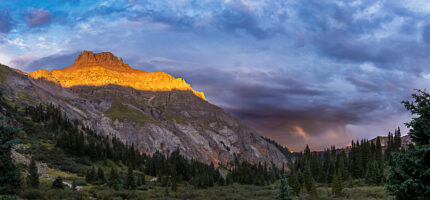In my quest to optimally process a sequence of images of Zodiacal Light and the Gegenschein in order to try and reveal the interplanetary dust in between, this time I instead used PTgui to assemble the 20 vertical images. Doing so yielded much better (and controlled) results of the Taylor Canyon 360° panorama, and in the first image below you can now visualize the arc of the ecliptic. I spent three nights solo at Taylor Canyon during the April new moon in 2018 and the ‘seeing’ conditions were phenomenal, as evidenced by the wedge of Zodiacal Light practically obliterating the Milky Way in the west.
In order to compile this 360° panorama I used 21 vertical images from a 50MP Canon 5Ds, which resulted in an 80×20″ print (native 1:1 resolution at 300dpi), which could reasonably be printed at 120×30″! Images were captured in 20° increments over the course of 9 minutes, with an additional 30° on the left and right sides to offset for the slightly-upward camera angle. Each image was 15 seconds at f/2.8, ISO 3200 using what I currently consider to be the finest astrophotography lens on the market (prime or zoom!), the Tamron SP 15-30mm f/2.8 Di VC.
Now for a little fun background that many of you may know a snippet about due to the recent film Bohemian Rhapsody. You’ve probably heard that Queen’s lead guitarist, Brian May, is an astrophysicist, a rather unique distinction for a rock god! Mr. May spent 33 years away from astrophysics, but finally returned to finish his doctoral thesis in 2007. Now here’s the fun part: his thesis–originally started nearly 40 years ago–concerned gathering spectrophotometer data of ‘Zodiacal Light’, which is the scattering of light off of dust in our solar system.
So, I can only assume that Mr. May would enjoy this image:

You can see more of my posts about Zodiacal Light here.
Being a 360° panorama, you can see many, many features of the night sky, however in this case it is more of a tour through the ‘winter’ night sky, as the galactic Center of the Milky Way didn’t rise until nearly 6 hours after this image was captured. I approximated the arc of the ecliptic based upon the subtle brightening of the area of the sky along the zodiac, and then afterward checked accuracy of the arc using Sky Safari 6 Pro; amazingly it turned out to be quite accurate, and I only had to adjust a bit near the horizon to get the position of the dashed line correct relative to a few bright stars. The lighter dotted lines forming the two ‘wedges’ were approximated by again trying to visualize the lightening in the sky around both the Gegenschein and Zodiacal Light. Locations of stars were used to approximately plot both the elevation and azimuth scales.
Click on the image below to bring up a higher-res copy:

The arc of green ‘airglow’ in the lower-left center of the image is a result of the atmosphere up to ~100 km luminescing due to the excitation of oxygen atoms from both ultraviolet light and cosmic rays from space. You can also see abundant (but faint) red airglow, which extends as high as 300 km above the earth’s surface. For those of you that think the green airglow looks a bit like the aurora borealis, that’s not far off, as the mechanism of luminescence is quite similar, although the ephemeral nature of aurora is due to the variability of outbursts of the sun’s electromagnetic radiation.
If you’ve never been to a true dark-sky location to see the Milky Way and all the heavens have to offer, I might suggest you add a trip to the Four Corners region of the Southwest U.S. to your bucket list. But remember to have at least one night without a campfire, as your eyes need at least 20-30 minutes in darkness to truly adapt and be able to see some of this stuff!

